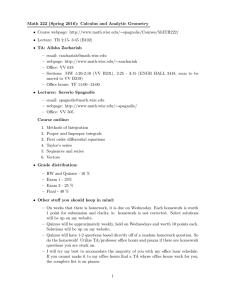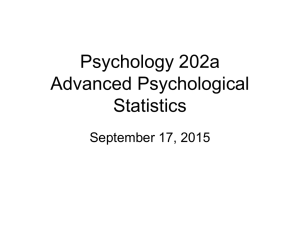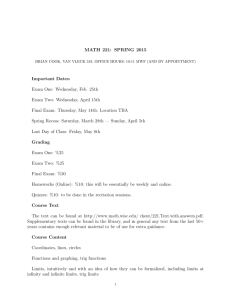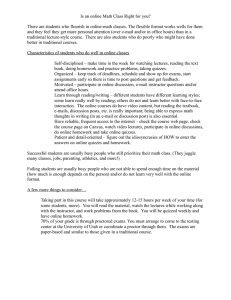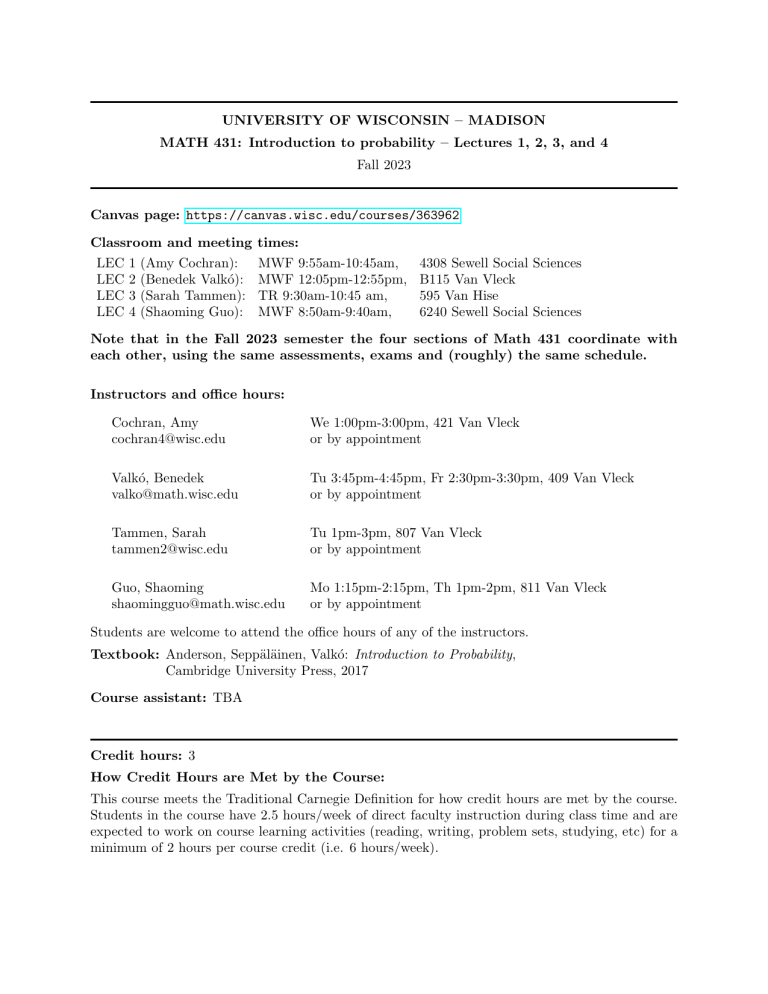
UNIVERSITY OF WISCONSIN – MADISON MATH 431: Introduction to probability – Lectures 1, 2, 3, and 4 Fall 2023 Canvas page: https://canvas.wisc.edu/courses/363962 Classroom and meeting times: LEC LEC LEC LEC 1 2 3 4 (Amy Cochran): (Benedek Valkó): (Sarah Tammen): (Shaoming Guo): MWF 9:55am-10:45am, MWF 12:05pm-12:55pm, TR 9:30am-10:45 am, MWF 8:50am-9:40am, 4308 Sewell Social Sciences B115 Van Vleck 595 Van Hise 6240 Sewell Social Sciences Note that in the Fall 2023 semester the four sections of Math 431 coordinate with each other, using the same assessments, exams and (roughly) the same schedule. Instructors and office hours: Cochran, Amy cochran4@wisc.edu We 1:00pm-3:00pm, 421 Van Vleck or by appointment Valkó, Benedek valko@math.wisc.edu Tu 3:45pm-4:45pm, Fr 2:30pm-3:30pm, 409 Van Vleck or by appointment Tammen, Sarah tammen2@wisc.edu Tu 1pm-3pm, 807 Van Vleck or by appointment Guo, Shaoming shaomingguo@math.wisc.edu Mo 1:15pm-2:15pm, Th 1pm-2pm, 811 Van Vleck or by appointment Students are welcome to attend the office hours of any of the instructors. Textbook: Anderson, Seppäläinen, Valkó: Introduction to Probability, Cambridge University Press, 2017 Course assistant: TBA Credit hours: 3 How Credit Hours are Met by the Course: This course meets the Traditional Carnegie Definition for how credit hours are met by the course. Students in the course have 2.5 hours/week of direct faculty instruction during class time and are expected to work on course learning activities (reading, writing, problem sets, studying, etc) for a minimum of 2 hours per course credit (i.e. 6 hours/week). Course Designation and Attributes: Breadth - Natural Science Level - Advanced L&S Credit - Counts as Liberal Arts and Science credit in L&S Requisites: MATH 234 or 376 or graduate/professional standing or member of the Pre-Masters Mathematics (Visiting International) Program Course description: Official: Topics covered include axioms of probability, random variables, the most important discrete and continuous probability distributions, expectation and variance, moment generating functions, conditional probability and conditional expectations, multivariate distributions, Markov’s and Chebyshev’s inequalities, laws of large numbers, and the central limit theorem. Math 431 is an introduction to the theory of probability, the part of mathematics that studies random phenomena. We model simple random experiments mathematically and learn techniques for studying these models. Topics covered include axioms of probability, random variables, the most important discrete and continuous probability distributions, expectations, moment generating functions, conditional probability and conditional expectations, multivariate distributions, Markov’s and Chebyshev’s inequalities, laws of large numbers, and the central limit theorem. Grading: Course grades will be based on the following class components: Homework: Quizzes: Midterm 1: Midterm 2: Final exam: 10% 7% 25% 25% 33% The following grade lines are guaranteed in advance. A percentage score in the indicated range guarantees at least the letter grade next to it. [100,89) A, [89,87) AB, [87,76) B, [76,74) BC, [74,62) C, [62,50) D, [50,0] F. Final letter grades are not curved but the grade lines above may be lowered at the end. Class attendance is not part of the grading. Class components Lectures: Lectures will be delivered in-person and synchronously two (for LEC 3) or three times (for LEC 1,2, and 4) a week during regular class hours. Lectures will involve some active learning components (e.g., problems and small group work). Attendance and active engagement is expected. Piazza: The online discussion forum, known as Piazza, will be used to discuss ideas or questions outside of class. Piazza can be used to get hints on homework problems, but no one is allowed to post entire solutions to homework assignments. However, feel free to post entire solutions to practice problems. Logistic questions are usually better posted on Piazza rather than emailed to the instructor, so all students can benefit from the answer. Homework: Homework assignments are due roughly every Friday. Assignments will be posted on Canvas, and they will have to be submitted in Canvas as a single pdf file. • No late assignments will be accepted. • Observe rules of academic integrity. Handing in plagiarized work, whether copied from a fellow student or off the internet, is unacceptable. Plagiarism cases will lead to sanctions. • Neatness and clarity are essential. Write one problem per page except in cases of very short problems. You are encouraged to use LaTeX to typeset your solutions. Write in complete English or mathematical sentences. • Computations without appropriate explanation will not receive credit, even if the final numerical answer is correct. If the answer is a simple fraction or expression, a decimal answers from a calculator is not necessary. For some exercises you will need a calculator to get the final answer. • If you do use outside resources for help, cite your sources properly. However, it is better to attack the problem with your own resources instead of searching the internet. The purpose of the homework is to strengthen your skills for problem solving skills, not internet searches. • It is valuable to discuss ideas for homework problems with other students. But it is not acceptable to write solutions together or to copy another person’s solution. In the end, you have to hand in your own personal work. Similarly, finding solutions on the internet is tantamount to cheating. It is the same as copying someone else’s solution. Quizzes: You will have a Mastery Check Quiz on basic set operations, and basic counting techniques, counting for 2% of your course grade. You have to complete this quiz by September 22, you will have unlimited attempts to retake it. You will also have regular weekly quizzes, usually due on Tuesday. These quizzes will be short assignments on Canvas to primarily test comprehension of lectures and prerequisite material. A quiz could involve definitions, computation, or comprehension. You will have 2 attempts for each weekly quiz, late quizzes will not be accepted. These weekly quizzes will count for 5% of your course grade. Exams: The course has two evening midterm exams and a final exam. First Midterm: Wednesday, Oct 11, 7:30pm–9pm Second Midterm: Wednesday, November 15, 7:30pm–9pm Final Exam: Friday, December 15, 2:45pm–4:45pm Students with academic or religious conflict with one of the exams should notify the instructor as soon as possible, and no later than the fourth week of the semester. Challenge problems: We will also post challenge problems during the semester. These will be graded separately from the regular homework assignments. The total score from the challenge problems will be normalized at the end of the semester, usually the best problem solvers get a couple of extra points towards their final grade. These problems are not graded like the rest of the homework, with ordinary standards of partial credit. The scale for the challenge problems is 0-3, with 0 unless you make significant progress towards the answer. Note that you do not need to work on these problems if you do not want to, they are there for the students who enjoy working on harder problems. Learning outcomes • Recall and state the formal definitions of the mathematical objects and their properties used in probability theory (e.g., probability spaces, random variables and random vectors and their probability distributions, named distributions, conditional probability, independence, linearity of expectation, etc.). • Use such definitions to argue that a mathematical object does or does not have the condition of being a particular type or having a particular property (e.g., whether certain events or random variables are independent or not, whether a random variable has one of the named distributions, whether or not a sequence of random variables is exchangeable, etc.). • Recall and state the standard theorems of probability theory. (e.g., Bayes’ theorem, the law of large numbers, the central limit theorem, etc.), and apply these theorems to solve problems in probability theory. • Use multiple approaches to compute and estimate probabilities and expectations (e.g., using the indicator method, using conditioning, estimating probabilities using normal or Poisson approximation etc.). • Construct mathematical arguments related to the above definitions, properties, and theorems, including the construction of examples and counterexamples. • Convey his or her arguments in oral and written forms using English and appropriate mathematical terminology and notation (and grammar). • Model simple real-life situations using techniques in probability theory and calculate probabilities and expectations associated with those models. How to Succeed in This Course Here are a couple of suggestions for being successful in this class: • The best way to learn math is by doing it. Try to work through the examples in the textbook before reading them, and try to solve as many practice problems as you can (on top of the homework problems). Let me know if you run out of problems to solve! • Attend the lectures, and try to be active in class. Ask questions if something is not clear. • Read the textbook. • In general, try to keep up with the material. We cover several topics in the class that build on each other, and it will be hard to catch up if you get behind in the material. • Use Piazza to ask questions related to the course material, and try to answer questions of other students if you can. • Take advantage of the office hours! I am happy to help you, but I cannot do that if you do not ask for it. • The Math Learning Center (in particular the Proof Table) could be a useful resource. Schedule (tentative) Weeks 1-2 Axioms of probability, sampling, consequences of the rules of probability Weeks 3-4 Conditional probability and independence Weeks 5-6 Random variables (distribution, expectation, variance) Weeks 6-7 Normal and Poisson approximation of binomial distribution Week 8 Moment generating function and transformation of random variables Weeks 9-12 Joint behavior of multiple random variables (joint distribution, expectation, covariance ) Week 13 Estimating tail probabilities, the Law of large numbers and the Central limit theorem Weeks 14-15 Conditional distribution and conditional expectation Accommodations for students with disabilities McBurney Disability Resource Center syllabus statement: “The University of Wisconsin-Madison supports the right of all enrolled students to a full and equal educational opportunity. The Americans with Disabilities Act (ADA), Wisconsin State Statute (36.12), and UW-Madison policy (Faculty Document 1071) require that students with disabilities be reasonably accommodated in instruction and campus life. Reasonable accommodations for students with disabilities is a shared faculty and student responsibility. Students are expected to inform faculty [us] of their need for instructional accommodations by the end of the third week of the semester, or as soon as possible after a disability has been incurred or recognized. Faculty [we], will work either directly with the student [you] or in coordination with the McBurney Center to identify and provide reasonable instructional accommodations. Disability information, including instructional accommodations as part of a student’s educational record, is confidential and protected under FERPA.” http://mcburney.wisc.edu/facstaffother/faculty/syllabus.php Teaching & Learning Data Transparency Statement The privacy and security of faculty, staff and students’ personal information is a top priority for UW-Madison. The university carefully evaluates and vets all campus-supported digital tools used to support teaching and learning, to help support success through learning analytics, and to enable proctoring capabilities. View the university’s full teaching and learning data transparency statement. Privacy of Student Records & the Use of Audio Recorded Lectures Statement View more information about FERPA. Lecture materials and recordings for this course are protected intellectual property at UW-Madison. Students in this course may use the materials and recordings for their personal use related to participation in this class. Students may also take notes solely for their personal use. If a lecture is not already recorded, you are not authorized to record our lectures without our permission unless you are considered by the university to be a qualified student with a disability requiring accommodation. [Regent Policy Document 4-1] Students may not copy or have lecture materials and recordings outside of class, including posting on internet sites or selling to commercial entities. Students are also prohibited from providing or selling their personal notes to anyone else or being paid for taking notes by any person or commercial firm without the instructor’s express written permission. Unauthorized use of these copyrighted lecture materials and recordings constitutes copyright infringement and may be addressed under the university’s policies, UWS Chapters 14 and 17, governing student academic and non-academic misconduct. Course Evaluations UW-Madison uses a digital course evaluation survey tool called AEFIS. For this course, you will receive an official email two weeks prior to the end of the semester, notifying you that your course evaluation is available. In the email you will receive a link to log into the course evaluation with your NetID. Evaluations are anonymous. Your participation is an integral component of this course, and your feedback is important to us. We strongly encourage you to participate in the course evaluation. Students’ Rules, Rights & Responsibilities View the university’s privacy rights (FERPA). Diversity & Inclusion Statement Diversity is a source of strength, creativity, and innovation for UW-Madison. We value the contributions of each person and respect the profound ways their identity, culture, background, experience, status, abilities, and opinion enrich the university community. We commit ourselves to the pursuit of excellence in teaching, research, outreach, and diversity as inextricably linked goals. The University of Wisconsin-Madison fulfills its public mission by creating a welcoming and inclusive community for people from every background – people who as students, faculty, and staff serve Wisconsin and the world. Academic Integrity Statement By virtue of enrollment, each student agrees to uphold the high academic standards of the University of Wisconsin-Madison; academic misconduct is behavior that negatively impacts the integrity of the institution. Cheating, fabrication, plagiarism, unauthorized collaboration, and helping others commit these previously listed acts are examples of misconduct which may result in disciplinary action. Examples of disciplinary action include, but is not limited to, failure on the assignment/course, written reprimand, disciplinary probation, suspension, or expulsion. • • • • • • Campus Resources for Academic Success University Health Services Undergraduate Academic Advising and Career Services Office of the Registrar Office of Student Financial Aid Dean of Students Office Graduate Student Services Academic Calendar & Religious observance View the university’s current and future academic calendars, along with the religious observance policy.
